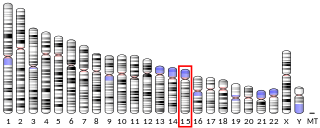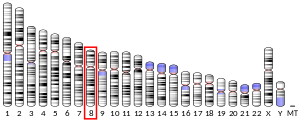
Ras-related protein Rab-5B is a protein that in humans is encoded by the RAB5B gene.

DNA-damage-inducible transcript 4 (DDIT4) protein also known as protein regulated in development and DNA damage response 1 (REDD1) is a protein that in humans is encoded by the DDIT4 gene.

Actin-binding LIM protein 3 is a protein that in humans is encoded by the ABLIM3 gene.

HIG1 domain family member 1A (HIGD1A), also known as hypoglycemia/hypoxia inducible mitochondrial protein1-a (HIMP1-a) and hypoxia induced gene 1 (HIG1), is a protein that in humans is encoded by the HIGD1A gene on chromosome 3. This protein promotes mitochondrial homeostasis and survival of cells under stress and is involved in inflammatory and hypoxia-related diseases, including atherosclerosis, ischemic heart disease, and Alzheimer’s disease, as well as cancer.

BTB/POZ domain-containing protein 1 is a protein that in humans is encoded by the BTBD1 gene.

Myotubularin-related protein 6 is a protein that in humans is encoded by the MTMR6 gene.

Semaphorin-4F is a protein that in humans is encoded by the SEMA4F gene.

Growth hormone-inducible transmembrane protein (GHITM), also known as transmembrane BAX inhibitor motif containing protein 5 (TMBIM5), is a protein that in humans is encoded by the GHITM gene on chromosome 10. It is a member of the BAX inhibitor motif containing (TMBIM) family and localizes to the inner mitochondrial membrane (IMM), as well as the endoplasmic reticulum (ER), where it plays a role in apoptosis through mediating mitochondrial morphology and cytochrome c release. Through its apoptotic function, GHITM may be involved in tumor metastasis and innate antiviral responses.

Zinc finger protein 43 is a protein that in humans is encoded by the ZNF43 gene.

Ergosterol biosynthetic protein 28 is a protein that in humans is encoded by the ERG28 gene.

Beta-taxilin is a protein that in humans is encoded by the TXLNB gene.

Transmembrane protein 47 is a protein that in humans is encoded by the TMEM47 gene.

High-mobility group protein B3 is a protein that in humans is encoded by the HMGB3 gene.

Synaptotagmin-13 is a protein that in humans is encoded by the SYT13 gene.

RNA-binding protein MEX3B is a protein that in humans is encoded by the MEX3B gene.

Zinc finger protein 34 is a protein that in humans is encoded by the ZNF34 gene.

Ankyrin repeat domain-containing protein 13C is a protein that in humans is encoded by the ANKRD13C gene.

Leiomodin-3 is a protein that in humans is encoded by the LMOD3 gene. Leiomodin-3 is especially present at the pointed end of muscle thin filaments.

HORMA domain-containing protein 1 (HORMAD1) also known as cancer/testis antigen 46 (CT46) is a protein that in humans is encoded by the HORMAD1 gene.

60S ribosomal protein L10-like is a protein that in humans is encoded by the RPL10L gene.



















